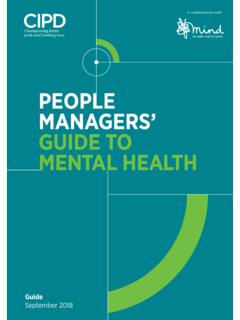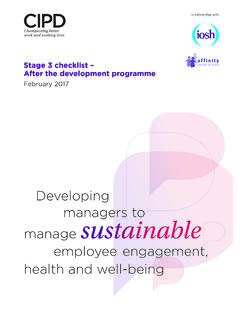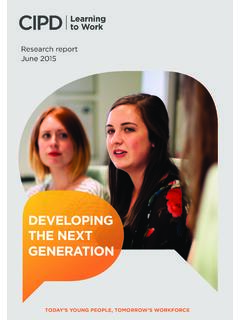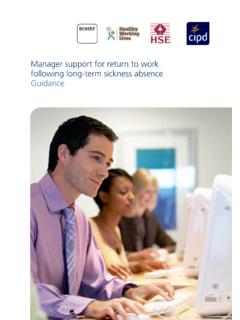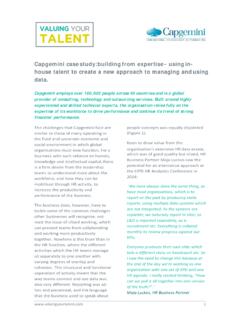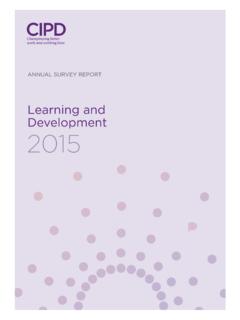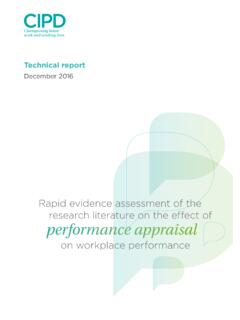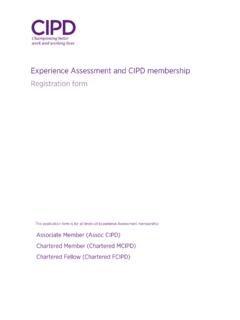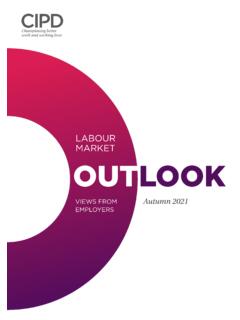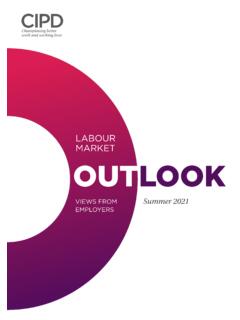Transcription of ROTTEN APPLES, BAD BARRELS AND STICKY SITUATIONS - CIPD
1 Research report April 2019 ROTTEN APPLES, BAD BARRELS AND STICKY SITUATIONS An evidence review of unethical workplace behaviourThe CIPD is the professional body for HR and people development. The not-for-profit organisation champions better work and working lives and has been setting the benchmark for excellence in people and organisation development for more than 100 years. It has 150,000 members across the world, provides thought leadership through independent research on the world of work, and offers professional training and accreditation for those working in HR and learning and apples, bad BARRELS and STICKY situationsResearch reportRotten apples, bad BARRELS and STICKY SITUATIONS : an evidence review of unethical workplace behaviour Contents Foreword 2 Executive summary 3 Introduction 6 What is unethical workplace behaviour?
2 8 ROTTEN apples: individual differences and unethical behaviour 10 Bad BARRELS : culture, climate and leadership 14 STICKY SITUATIONS 19 Codes of conduct, communication and training 22 Conclusions and recommendations 26 Notes 28 AcknowledgementsThis report was written by Jonny Gifford and Melanie Green (CIPD), Eric Barends and Barbara Janssen (Centre for Evidence-Based Management), and Alessandra Capezio, assisted by Nguyen (Paul) Ngo (Australian National University). The rapid evidence assessment this report is based on was conducted by the above authors and Louisa Baczor, Heather Bond, Marion Craig, Ed Houghton, Wilson Wong of the CIPD, and Ksenia Zheltoukhova and Ramya Yarlagadda, formerly of the CIPD. 1 ROTTEN apples, bad BARRELS and STICKY situationsForeword1 ForewordEthical issues have been front and centre of the 24 hour news-cycle for many years.
3 From Deepwater Horizon, to the Panama Papers and the LiBOR scandal, ethics and the appropriateness of decisions by senior business leaders has become a topic of real debate. Most recently the UK has been rocked by the high-profile failure of Carillion, a key supplier of UK government contracts, and a significant pensions scandal at high-street retailer BHS. Not only are these ethical issues clear signals of failures in governance and compliance, they re also a leading indicator, and cause of falling trust. Trust in business, trust in government, and trust in the regulations and systems designed to protect individuals and the economy. It s widely acknowledged that codes alone will not fix the chasms between espoused values and real actions. A critique of the recent past is that ethical issues have arisen even in systems in which the right checks and balances are in place: clear corporate values, comprehensive regulatory frameworks, strong governance structures.
4 The reality is that codes and the tools to support them are not enough, and over-reliance on them create blind-spots and inaction. Instead we must reflect on the nature of ethical breaches and look deeper into where they come from, what they consist of, and how they play out. This idea is what we ve developed in this research, by looking into academic literature and surfacing the evidence describing ethics at work today. Looking at the media you would think the likelihood of ethical breaches occurring is moderate to low occasionally a business is faced with a critical issue. Of course, the opposite is true. We know from our own People Profession survey that these issues are more common than we think; just under a third (31%) of people professionals say that managers in their organisations often demonstrate unethical behaviour, and a large minority of people professionals find themselves in positions where the organisation s expectations are at conflict with their professional beliefs (28%) (find out more at ).
5 The challenge of maintaining a strong ethical climate is something which many people professionals tackle through their professional practice. Our members are on the front line of ethical issues when they arise and are often the experts called on to fix issues and bring stability back to the business. This research is designed to highlight and critique the evidence surrounding ethical issues in organisations today and provide pointers to people professionals and their senior stakeholders as to how to navigate these so-called STICKY - SITUATIONS . Only by diving into high quality, robust and relevant research can we properly map the terrain and provide effective support and guidance. We hope that through this work we offer insights that enable people professionals to continue to guard against ethical issues and act as and when they arise.
6 We know that their unique expertise and effective leadership are critical to changing business practice for the better. Ed HoughtonHead of Research and Thought Leadership, CIPD2 ROTTEN apples, bad BARRELS and STICKY situationsExecutive summary2 Executive summary Workplace ethics have never been long out of the public spotlight over recent years. Following various workplace scandals, attention has turned to reforming corporate governance, increasing regulation and raising industry standards, and how to build better business cultures. Despite this, corporate scandal persists, and trust in businesses continues to be eroded by issues such as executive build more ethical businesses, it is also important to understand the organisation-level risk factors that contribute to unethical behaviour. This understanding provides an avenue through which business leaders and HR professionals can target intervention in the day-to-day running of organisations.
7 This report investigates how employers can foster ethical behaviour by asking three questions:1 To what extent is unethical behaviour the result of individual choices?2 To what extent is unethical behaviour the result of organisation or industry-wide problems, in particular organisational culture or ingrained norms of behaviour? 3 To what extent is unethical behaviour due to the difficult or compromising nature of decisions that people face? The report is based on a rapid evidence assessment (REA) that can be found at The REA identified a large body of research on the drivers of ethical and unethical workplace behaviour. In this report we explore the key findings and discuss the implications for people professionals and businesses. We identify nine main areas of actions employers can take that, based on the best available evidence, are most likely to have a positive impact on workplace ethics.
8 We summarise these below. 1 Consistently enforce codes of conduct Develop a code of conduct that is accessible, meaningful and uses concrete examples of ethical behaviour to reduce ambiguity about what is acceptable and what is not acceptable. Reinforce the code of conduct through core training that encourages employees to consider the ethical outcomes of decisions and reinforces individual responsibility. Enforce the code of conduct consistently and fairly across all of conduct provide important reference points for and reminders of ethical standards, but if they are not actively enforced they will do little to promote ethical behaviour. Training on codes of conduct should not be a one-off exercise; for example, it should be present in induction training and ongoing professional development. Consistent enforcement is especially important considering that high performers are less likely to be reprimanded for acting Communicate carefully about unethical behaviour and ethical standards Communicate carefully about the extent of ethical issues: be transparent about challenges but avoid creating a sense that everybody else is doing it.
9 Pay attention to the way messages are framed emphasise what s to gain from ethical standards, rather than what s to lose from unethical behaviour. Senior leaders should reinforce positive norms by role-modelling ethical behaviour and through the messages they communicate. Give reminders of the importance of ethical behaviour and target these in high-risk SITUATIONS . 3 ROTTEN apples, bad BARRELS and STICKY situationsExecutive summaryOrganisational norms the way things are done in a business are an important influence on behaviour. The behaviour of others is an important cue especially from senior leaders and unethical behaviour can be contagious. Timely reminders can make a clear difference on ethical behaviour, especially in circumstances when there is pressure to behave unethically. Based on an understanding of who is most at risk and when, reminders can be targeted at groups or SITUATIONS in which unethical behaviour is more likely for example employees working in high-pressure or competitive environments.
10 3 Focus on ethical climate and the organisational practices that shape it Focus on climate rather than culture; ethical climate is influenced by tangible factors and is linked to a variety of outcomes. Seek to understand what type of ethical climate your organisation has for example, egoistic, benevolent or principled. Reflect on how the organisation s systems, procedures and informal practices shape ethical climate and culture. Culture is often referred to as a factor that explains unethical behaviour, but the concept of culture can be nebulous. Instead, organisations can focus on understanding and shaping their ethical climate, which is influenced by tangible factors such as practices and procedures. Ethical climate is also linked to other outcomes such as job satisfaction and employee well-being: when the norm is to act in self-interest and neglect the interests of the wider community, colleagues suffer as well as ethical standards.
